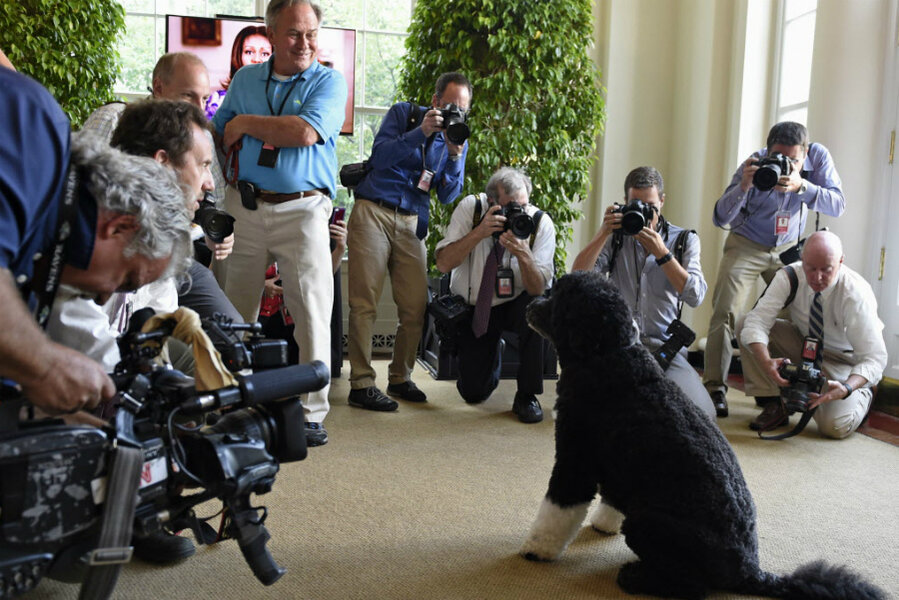National Dog Day: top 5 presidential pooches
Loading...
Presidents need dogs. They might need dogs more than almost anyone else in the United States. Think of the rigors of the office: After a long day of failing to calm the Middle East, or hours spent listening to Congress yap about your latest budget, the calming effect of a pooch must seem like relative bliss.
They’ll rest their head on your arm. They’ll look at you with big, brown eyes. They won’t say anything about the trend line of your favorability ratings.
That said, not all presidential dogs are good dogs. Or rather, not all are effective at their role, which is serving as combination of companion and political symbol.
Take King Timahoe, Richard Nixon’s Irish setter. A gift from staffers, King Timahoe was a nervous dog, and thus not a perfect match for a nervous chief executive. The pair would eye each other warily. It was difficult to lure the dog next to Mr. Nixon for the obligatory photos of the world leader with his canine companion.
“Had Tim in the office, can’t get him to come over by P’s desk, he’s trying dog biscuits, no use,” wrote Nixon’s Chief of Staff H.R. Haldeman in his diary entry for Jan. 31, 1969.
Other president-dog pairings worked out better. In honor of National Dog Day, here’s a list of five good ones, ranked.
Laddie Boy and Warren Harding. A handsome Airedale terrier, Laddie Boy was the perfect symbol for a president whose campaign slogan had been "a return to normalcy.” Laddie Boy seemed, well, normal, and became the first presidential pet to receive extensive news coverage in his own right. After Harding’s death in office, newsboys around the country donated 19,000 pennies for a memorial. These coins were melted down and cast into a life-size Laddie Boy sculpture, today owned by the Smithsonian.
King Tut and Herbert Hoover. A large Belgian police dog, King Tut helped Hoover win the 1928 election. An iconic campaign photo depicted a smiling Hoover holding up family pet Tut by his front paws. Handed out to voters by the thousands, the photo softened Hoover’s dour image.
Murray the Outlaw and FDR. Murray the Outlaw of Falahill – better known as “Fala” – served as Franklin D. Roosevelt’s virtual chief of staff. Every morning, he had a bone that was brought up on FDR’s breakfast tray. He slept in a special chair at the foot of FDR’s bed. He traveled the world with the president to wartime conferences, at times entertaining other leaders by curling his lip into a doggie version of a smile, on command.
Bo and Barack Obama; Barney and George W. Bush (tie). Bo and Barney come from opposite ends of the pet political spectrum. But they share the distinction of being pioneers at the modern game of viral media. Both served their administrations well by donning embarrassing headgear in the name of clicks and not complaining about it. In 2012, Portuguese water dog Bo had to wear pink bunny ears and pretend to lay an egg in a video advertising the upcoming White House Easter Egg Roll. Back in 2007, Scottish terrier Barney was outfitted with a headdress of roses that he was forced to “deliver” to fellow pet Miss Beazley.
Charlie and JFK. A Welsh terrier, Charlie was perhaps John F. Kennedy’s favorite dog. In this role, he may have helped pull the world back from the brink of nuclear conflict.
At the height of the Cuban missile crisis, in 1962, JFK summoned Charlie to the chaotic Oval Office, according to then-White House kennel keeper Traphes Bryant. Soviet ships were steaming toward Cuba. The US Navy was getting ready to stop them. War seemed close at hand.
JFK petted Charlie for some time. The president seemed to relax. Then he handed the dog back to the kennel keeper and said, “I suppose it’s time to make some decisions.”
Kennedy, in the end, decided to exercise restraint, against the advice of many in his cabinet. That helped de-escalate the situation, as the superpowers stepped back from what would later stand as their most dangerous nuclear confrontation.








